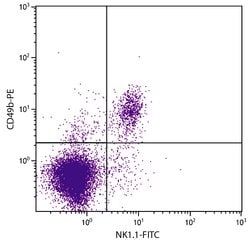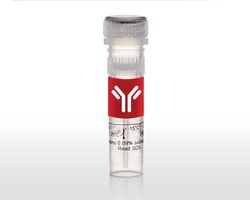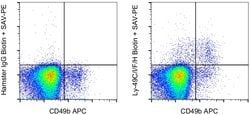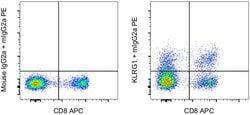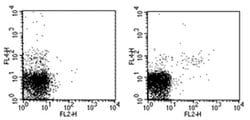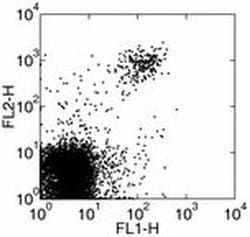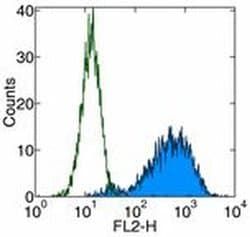NK1.1 Monoclonal Antibody (PK136), Functional Grade, eBioscience™, Invitrogen™
Manufacturer: Invitrogen
Select a Size
| Pack Size | SKU | Availability | Price |
|---|---|---|---|
| Each of 1 | 16-594-138-Each-of-1 | In Stock | ₹ 2,54,540.00 |
16-594-138 - Each of 1
In Stock
Quantity
1
Base Price: ₹ 2,54,540.00
GST (18%): ₹ 45,817.20
Total Price: ₹ 3,00,357.20
Antigen
NK1.1
Classification
Monoclonal
Concentration
1 mg/mL
Formulation
PBS with no preservative; pH 7.2
Gene Accession No.
P27812, P27814
Gene Symbols
Klrb1b, Klrb1c
Purification Method
Affinity chromatography
Regulatory Status
RUO
Gene ID (Entrez)
17059, 80782
Content And Storage
4° C
Form
Liquid
Applications
Flow Cytometry, Functional Assay
Clone
PK136
Conjugate
Functional Grade
Gene
Klrb1b
Gene Alias
AI462337; CD161; CD161 antigen-like family member B; CD161 antigen-like family member C; CD161b; CD161c; EMBL:AAQ11375.1}; Inhibitory receptor NKR-P1B; killer cell lectin-like receptor subfamily A member 1C; killer cell lectin-like receptor subfamily B member 1B; killer cell lectin-like receptor subfamily B member 1B allele A; Killer cell lectin-like receptor subfamily B member 1B allele B; killer cell lectin-like receptor subfamily B member 1B allele C; killer cell lectin-like receptor subfamily B member 1C; killer cell lectin-like receptor subfamily B member 1D; killer cell lectin-like receptor subfamily B member 1F; KLRB1; Klrb1b; klrb1b {ECO:0000312; Klrb1c; Klrb1d; Klrb1f; klrb1f {ECO:0000250; Ly55; Ly-55; Ly55b; ly-55b; Ly55c; ly-55c; Ly55d; Ly-55d; Ly59; Ly-59; lymphocyte antigen 55 complex, locus B; lymphocyte antigen 55 complex, locus C; lymphocyte antigen 55 complex, locus D; lymphocyte antigen 55b; lymphocyte antigen 55c; Lymphocyte antigen 55d; lymphocyte antigen 59; MGC163
Host Species
Mouse
Quantity
5 mg
Primary or Secondary
Primary
Target Species
Mouse
Product Type
Antibody
Isotype
IgG2a κ
Description
- The PK136 MAb reacts with mouse NK1.1, an antigen expressed by natural killer cells and a subset of T cells in the NK1.1 mouse strains including C57BL and NZB
- Several commonly used laboratory mouse strains such as BALB/c, SJL, AKR, CBA, C3H and A do not express the NK1.1 antigen
- For detection of NK cells in these strains the MAb DX5 (Cat
- No
- 14-5971) should be used
- Simultaneous staining of C57BL/6 spleen cells with PK136 and DX5 reveals coexpression of both markers by a majority of cells as well as presence of small populations of DX5+PK136- and DX5-PK136+ cells
- Applications Reported: PK136 has been reported for use in flow cytometric analysis, depletion of NK cells, and in vitro functional studies
- Applications Tested: The PK136 antibody has been tested by flow cytometric analysis of C57Bl/6 mouse splenocytes and can be used at less than or equal to 0.5 μg per test
- A test is defined as the amount (μg) of antibody that will stain a cell sample in a final volume of 100 μL
- Cell number should be determined empirically but can range from 10^5 to 10^8 cells/test
- It is recommended that the antibody be carefully titrated for optimal performance in other applications
- Storage and handling: Use in a sterile environment
- Filtration: 0.2 μm post-manufacturing filtered
- Purity: Greater than 90%, as determined by SDS-PAGE
- Endotoxin Level: Less than 0.001 ng/ μg antibody, as determined by LAL assay
- Aggregation: Less than 10%, as determined by HPLC
- NK1.1 (Killer cell lectin-like receptor subfamily B, member 1, KLRB1, NKR-P1A, CD161, cluster of differentiation 161), refers to Natural Killer (NK) cells, lymphocytes that mediate cytotoxicity and secrete cytokines after immune stimulation
- Several genes of the C-type lectin superfamily, including the rodent NKRP1 family of glycoproteins, are expressed by NK cells and may be involved in the regulation of NK cell function
- The KLRB1 protein contains an extracellular domain with several motifs characteristic of C-type lectins, a transmembrane domain, and a cytoplasmic domain
- The KLRB1 protein, NKR-P1A or CD161, is classified as a type II membrane protein because it has an external C terminus
- NKR-P1A, the receptor encoded by the KLRB1 gene, recognizes Lectin Like Transcript-1 (LLT1) as a functional ligand.
